As you see, I’m posting this on the eve of December 16th.
And what’s so special about December 16th?
It’s a big Tea Party day. Not the loose confederation of small-government, low-tax advocates who will be sending 30 or so rambunctious representatives to Congress come January and who are making all that political noise across the United States.
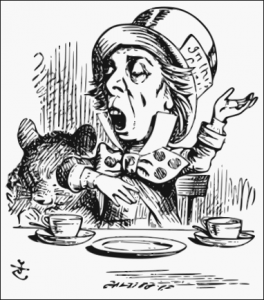
The hatter, or mad hatter, had something to say at HIS tea party just as speakers at Tea Party rallies do today. (Wikipedia Commons)
Not a real tea party — the kind where folks sip from delicate china and stick out their pinkies in a sort of upper-crust code of hoity-toitiness. Not the Alice in Wonderland tea party with the Mad Hatter from the fable, either.
December 16th is the anniversary of THE Tea Party, a little get-together in Boston 237 years ago. It is that affair that inspired and gave the name to the political Tea Party of today.
More about those events in 1773 shortly.
First, though, if you’ve just heard tell, as mother used to say, about today’s Tea Party, be aware:
It’s not yet — and “yet” could be the operative word — a full-fledged, official political party at all — except in Florida, where someone registered the name. It has no party chairman, no place by name on any ballot, no cute elephant or donkey symbol.
Tea partiers are, however, partial to a snake. That’s not a slap. I’m talking real snake, or at least a colorful symbol of one shown on the “Gadsden Flag” that dates all the way back to the American Revolution. That’s when some hastily mustered patriot marines marched about with drums painted bright yellow and carrying the image of a coiled rattlesnake and the slogan “Don’t Tread on Me.” That saying and snake symbol then showed up on a flag presented to the patriot navy’s commander by Christopher Gadsden, who led the rebellious “Sons of Liberty” in his home colony of South Carolina.
Tea partiers of today are partial to the menacing snake and defiant “Don’t Tread on Me” slogan. Some are “all in” with the American Revolution metaphor, calling the Tea Party the “Patriot” movement.
The Tea Party that’s shaking up Washington is indeed a phenomenon as well as an alliance of kindred conservatives — some prefer to say libertarians or populists, which would take a whole other blog to explain. Tea partiers think of themselves as a grassroots bunch, which implies a natural and spontaneous emergence from the hinterlands. For sure, the coalescence around lowering government spending, taxes, and the national debt didn’t start in the overstuffed chairs of Wall Street or the U.S. Capitol.
But cynics and critics argue that Tea Party protests, which began early last year, were more AstroTurf than natural grass, meaning that, like the synthetic carpet made to look like shoots of green grass, Tea Party gatherings were calculated events choreographed by savvy politicians and disguised as spontaneous uprisings and outcries.
Remember that word “disguised.” It plays a starring role in the historical Tea Party I’ll describe in a bit.

Former U.S. vice presidential candidate speaks at the kickoff of her “Tea Party Express” bus tour in October. Not sure what the “IV” is for. (AP Photo)
Some say that the “Tea Party Express” — another name for the modern movement — began on January 24, 2009, with a “tea party” rally against what protesters called “obesity taxes” proposed by New York Governor David Patterson. Many of the protesters wore American Indian headdresses for reasons I’ll also explain momentarily.
About three weeks later, the nascent movement exploded around a rant by news editor Rick Santelli on the cable financial network CNBC, aimed at the Obama Administration’s plan to provide financial assistance to some Americans with troubled mortgages.
“How about this, Mr. President and new administration,” Santelli yelped from the trading floor of the Chicago Mercantile Exchange. “Why don’t you put up a Web site to have people vote on the Internet as a referendum to see if we really want to subsidize the losers’ mortgages? Or would they like to at least buy cars, buy a house that is in foreclosure, give it to people who might have a chance to actually prosper down the road and reward people that can carry the water instead of drink the water?
“This is America!”
Santelli added, “How many people want to pay for your neighbor’s mortgages [for houses that have] an extra bathroom and can’t pay their bills? Raise their hand!” This prompted boos and shouts of “no!” from several of the commodity traders.
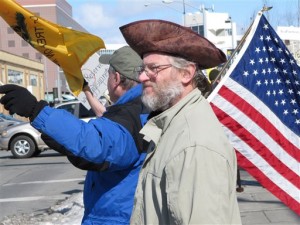
The American Revolution gets its due at this rally in Anchorage, Alaska, with another flying of the “Don’t Tread on Me” flag and the wearing of an early tri-corner hat. (AP Photo)
The outburst soon “went viral” on the Web and inspired raging debates that reached all the way to the White House briefing room.And it prompted passionate dialogue — and inspired instant blogs — on other Web sites that spread the anti-big-government outrage.
At one point in his diatribe, Rick Santelli mused, “I’ll tell you what. If you read our founding fathers, people like Benjamin Franklin and [Thomas] Jefferson . . . what we’re doing in this country now is making them roll over in their graves.”
Yes, but what about Sam Adams, another patriot of the American Revolution?
His story takes us to disguised “Indians” of old. 1773 old. That’s three years before the American Revolution erupted in earnest.
Like their friends, relatives, and ancestors in Britain, American colonists loved their tea, most of which was supplied by the corrupt and nearly bankrupt British East India Company. As with sugar, coffee, and newspaper imports from the motherland, tea from India was heavily taxed at a time when colonists by the thousands were beginning to roil against “taxation without representation.”
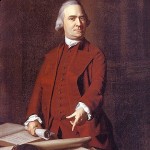
Sam Adams was a prolific and daring writer whose stirring words helped spur the “Indians” to toss British tea overboard. (Library of Congress)
Three East India Company ships sailed into Boston Harbor and anchored at Griffin’s Wharf, where their captains encountered some extremely agitated “Sons of Liberty,” led by philosopher and pamphleteer Samuel Adams, a cousin of the nation’s eventual second president.
“Get ye back to London, you blaggards!!!” or words to that effect, the Sons shouted, and for a week the three captains kept their ships anchored without unloading them.
Then, on a very cold December 16th evening, what is described as “a large band of patriots” crudely disguised as Mohawk Indians emerged from Boston’s South Meeting House, strode briskly to the wharf, and boarded the three anchored tea-carrying vessels.
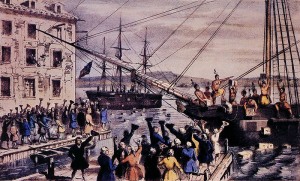
Nathaniel Currier created this “Destruction of Tea at Boston Harbor” lithograph in 1846. (Wikipedia Commons)
As thousands of spectators watched, reportedly in silence, they took axes to 342 crates of tea and methodically dumped their contents into the harbor.
“When all this was through,” writes the Web site for today’s Boston Tea Party Ships & Museum — “Lendall Pitts led the patriots from the wharf, tomahawks and axes resting on their shoulders. A fife played as they marched past the home where British Admiral [John] Montague had been spying on their work. Montague yelled as they pas[sed], ‘Well, boys, you have had a fine, pleasant evening for your Indian caper, haven’t you? But mind, you have got to pay the fiddler yet!’”
Pay, as in make monetary restitution for the destroyed tea. The Bostonians refused, prompting King George III’s government to impose even more coercive tariffs on the colonies. This, as every American schoolchild learns, would prove terribly counterproductive.
Protests spread, and the Sons of Liberty’s brazen act that night in 1773 became what many — including Tea Party enthusiasts today — regard as the spark that set off the American Revolution.

This is the “Beaver” in better days, before fire at the adjacent museum shut down the Boston Tea Party attraction. (Carol M. Highsmith)
I mentioned the Boston Tea Party Ships and Museum, which until recently have fared about as well as the tea did in Boston Harbor. The small entryway museum leading to a replica of the Beaver, one of three ships boarded by Sam Adams and his rabble-rousing pals, burned following a lightning strike in 2001, and the museum, which was struggling, never reopened, despite many fits and starts. Historic Tours of America in Boston assures me that plans to introduce not only a much grander museum, but also finer replicas of all three Tea Party ships — including one that will be constructed right at the site as an educational exhibit — are back on track with a target opening date next fall.
If the new arrangement is anything like the doings over at another famous Boston-berthed ship — the U.S. Navy’s historic “Old Ironsides” U.S.S. Constitution frigate moored at Charlestown Navy Yard — many re-enactments will ensue.
Ted's Wild Words
These are a few words from this posting that you may not know. Each time, I'll tell you a little about them and also place them into a cumulative archive of "Ted's Wild Words" in the right-hand column of the home page. Just click on it there, and if there's another word that you'd like me to explain, just ask!
Blaggard. A version of “blackguard” — a villain, scoundrel or absolutely contemptible person.The term dates to 16th-century England, where blackguards were servants of low regard, up to no good.
Hoity-toity. Self-important, pompous, stuck up. Oddly enough, the word traces to the Old English verb “hoit,” which had just the opposite meaning, involving noisy romps around a room. Hoity-toity people avoid hoiting at all cost!
Nascent. At an early stage of development, or just coming into existence, as in “the nascent information-technology movement.”
Rambunctious. Frisky, boisterous, often a bit out of control.

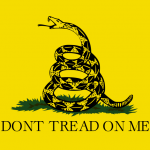
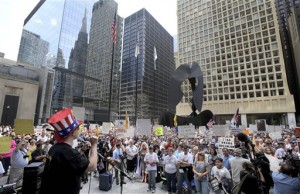

One response to “Pass the Tea”
Wow I needed this information for my homework, thanks alot!